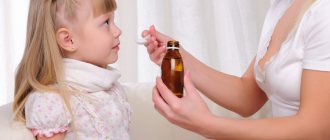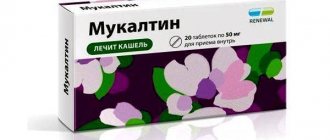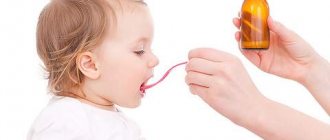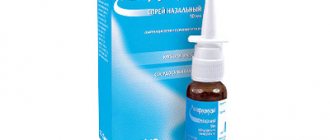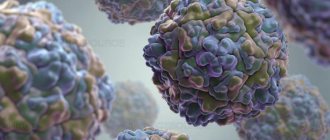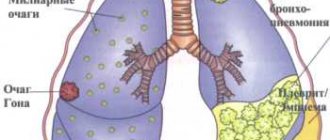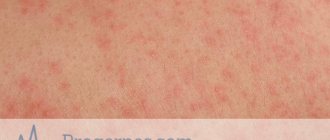Inhalations. Treatment of cough and runny nose in children.
Inhalation is a method of administering a drug by inhaling gas, steam or smoke containing the drug.
An inhaler is a device used for inhalation.
Inhalations have always been used and are still used to this day to treat various diseases of the upper respiratory tract. Inhalations are one of the most effective ways to treat coughs of various origins and runny nose. Inhalations are especially effective in children due to their accessibility, high efficiency and ease of use.
Young mothers know how difficult it can sometimes be to give medicine to their child, especially if it tastes bitter. How about putting it in your nose...? Scream for the whole house...
And even if a child allows himself to be treated, not all medications can be used for a long time. For example, vasoconstrictor sprays and nasal drops cannot be used for more than 5-7 days. Their long-term use is addictive. The so-called rebound syndrome or drug-induced rhinitis occurs. What to do? After all, not all babies have a cough and runny nose that goes away within a week. This is where inhalations will come to our aid.
Inhalation procedures can be carried out both in medical institutions and at home. All you need to do is purchase an inhaler at the pharmacy. Inhalations are prescribed for acute respiratory infections, acute respiratory viral infections, influenza, rhinitis, bronchitis, tonsillitis, sore throat, pharyngitis, and pneumonia. Inhalations are also effective for allergic coughs and asthma, when using a nebulizer and special medications prescribed by a doctor.
Steam inhalations.
Our grandmothers used this method in the good old days. Today it is not as popular as it used to be. This is due to the fact that steam inhalers have been replaced by new, more convenient and effective inhalers, or so-called nebulizers. But more about them a little later. Let's talk a little about steam inhalations.
Steam inhalations are carried out using a steam inhaler made of heat-resistant medical plastic, which can be bought at a pharmacy, or in the “old-fashioned” way over a saucepan, covered with a towel. For treatment, medicinal herbs, essential oils or medications are used, such as: a mixture for inhalation, ammonia-anise drops, and breast elixir. The therapeutic effect is achieved by the direct effect of steam-humid air and medicinal aerosols on the mucous membrane of the upper respiratory tract.
Steam-moist inhalation of medicinal aerosols helps moisturize the mucous membrane, improve blood circulation, activate the function of the ciliated epithelium, thin out viscous mucus, facilitate sputum discharge, soothe dry cough, and reduce the feeling of dry throat.
Mode of application. 300 - 350 ml of a previously prepared decoction of medicinal herbs is poured into a pan container and brought to a boil. Or boiling water is poured into the inhaler container, to which 1-2 drops of a drug solution or 1-2 drops of essential oil are added. This could be fir, pine, peppermint or juniper oil, tea tree oil, a mixture of essential oils for coughs or a mixture of essential oils for colds. An adapter with a mask attached to it is fixed to the container. The inhaler is ready for use. For a more complete penetration of the aerosol from the inhaler into the respiratory tract, tight contact with the mask is necessary.
Inhalations should be carried out while sitting, in a position comfortable for you, in a calm state, half an hour before meals, or 30 minutes after meals. Breathing should be calm and uniform. Inhalations are carried out 2 times a day for 15 minutes. The course is prescribed from 5 to 15 inhalations.
Medicinal plant materials that can be used for inhalation:
- Eucalyptus leaf
- sage leaf
- Peppermint leaf
- Coltsfoot leaf
- Chamomile flowers
- Pine buds
- Thyme herb
- Oregano herb
- Grass succession
- Chest collection No. 4
I use medicinal plants or their preparations in dried and crushed form: 1-2 tablespoons per 250 ml of boiling water.
Contraindications. High body temperature (over 37.50C); allergic reactions to medications, essential oils or herbs; tuberculosis; nosebleeds.
Please note: Be careful when the inhaler is filled with hot water; Do not leave children receiving inhalation unattended!
Machold inhaler.
Designed for steam inhalation, but unlike the inhaler described above, it has a more compact appearance and is made of impact-resistant, chemically resistant, heat-resistant medical glass. For inhalations, essential oils and alcoholic tinctures of medicinal herbs are used.
Indications for use:
- Respiratory diseases: pharyngitis, tonsillitis, rhinitis, tracheitis, bronchitis.
- ARI, ARVI, colds, flu
- To activate the body's protective functions
- Disorders of the cardiovascular and nervous systems: insomnia, stress, neuroses, angina pectoris, hypertension.
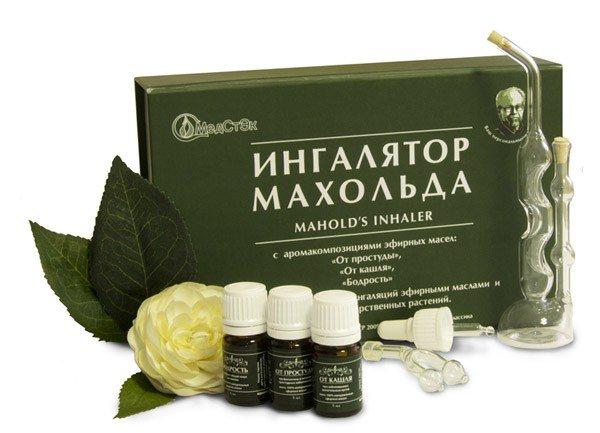
When carrying out inhalation using the Macholda inhaler, you will perform a gentle “warm” inhalation without irritating the skin of the face or the mucous membranes of the respiratory tract (unlike the “old-fashioned” method). A stream of warm air enriched with medicinal aerosols enters both the lower respiratory tract (when inhaling through the mouth) and the upper respiratory tract (when inhaling through the nose). The kit includes a special nozzle for inhalation through the nose.
Before use, the inhaler must be rinsed with warm running water. Pour 5-6 ml of warm water (35-400C) through a funnel and add the required number of drops of essential oil
or mixtures of essential oils. If an alcohol tincture of medicinal plants is used as an inhalation mixture, 5 ml of the tincture is poured into the inhaler without adding water. To enhance the inhalation effect, the bottom of the inhaler can be lowered into a container with hot water (60-800C).
Please note: before the procedure, it is necessary to test for the absence of an allergic reaction to essential oils or medicinal plant materials. Apply 1 drop of essential oil or tincture to the inner surface of the forearm or behind the ear, apply 2-3 drops to a handkerchief and inhale throughout the day. The test liquid can be used if after 12 hours there is no allergic reaction on the skin, headache, cough, shortness of breath, runny nose, or swelling of the face.
The dosage, frequency and duration of the course should be strictly observed. Inhalations are carried out 30 minutes before meals, or an hour after meals. Children over 3 years of age receiving inhalation must be supervised by adults.
Contraindications for use.
- Individual intolerance
- Pregnancy
- Children under 3 years old
- Exacerbation of bronchial asthma and pneumonia
- Acute cardiovascular failure
- Nosebleeds.
Compressor inhaler.
The principle of operation is that the medicine placed in the inhaler is converted into vapor due to the passage of air through it under high pressure.
For inhalation, you can use any medicine: Lazolvan solution, Ambrobene solution, Miramistin, Sodium chloride 0.9%, Derinat, Grippferon, Mineral waters: Essentuki, Borjomi, Narzan, as well as antibiotics and hormonal drugs prescribed by a doctor.
The inhaler is easy to use and has a long service life. With the help of such an inhaler, you can treat various diseases of the upper respiratory tract in both adults and very young children. All pediatricians believe that inhalation using an inhaler is one of the most effective ways to treat childhood respiratory diseases. By using it, you can achieve a quick recovery and reduce or completely stop taking various medications that can cause negative side effects.
But despite all the positive qualities of such an inhaler, it also has disadvantages. As a rule, such inhalers are very loud and noisy, which can frighten a child. Therefore, manufacturers took this fact into account and developed children's designs especially for children, which make less noise, are painted in bright colors and are shaped like toys. For inhalation, you cannot use medicinal plant materials and essential oils, as this may cause damage to the inhaler.

Mesh - nebulizers.
The most expensive inhaler, which does not have the disadvantages of the above-described inhalers. It is compact and very effective. When the mesh-membrane vibrates under the influence of ultrasound, an aerosol is formed, the particles of which have different sizes. This size can be adjusted by changing membranes for targeted delivery of the drug to those parts of the respiratory tract where it is needed. The sound is low-frequency, so the structure of the medicinal substance is not disturbed. Any medicine can be used.
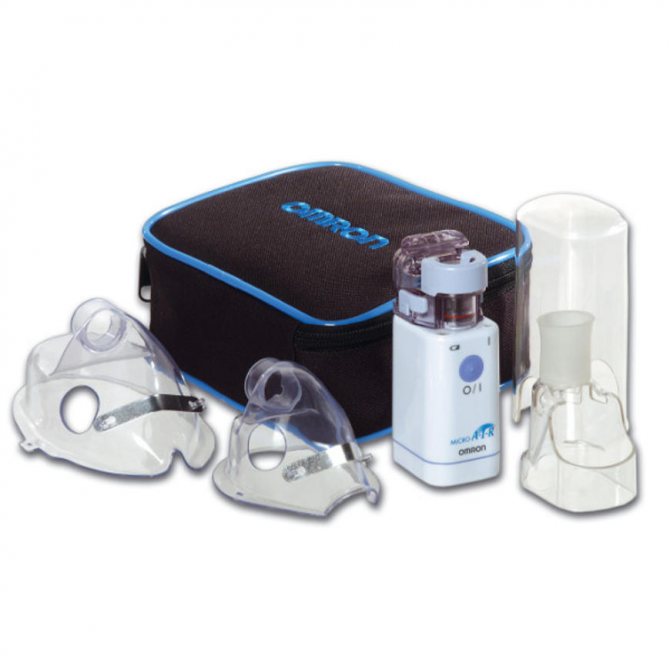
Currently, a nebulizer is a very popular device. Millions of people have already experienced its effectiveness. There are a huge number of positive reviews. Using an inhaler, the duration of colds and the incidence of respiratory diseases are significantly reduced. Excellent treatment for cough and runny nose. When you decide to purchase an inhaler, be sure to read the instructions or consult a specialist to make the right choice. Use only those medications that have been prescribed by your doctor and approved for use with this inhaler.
source
Dry cough
This painful condition can be identified by such characteristic symptoms as difficulty breathing caused by narrowing of the trachea and bronchi, discomfort during deep inspiration, whistling noises between coughing impulses.
Typically, a dry cough signals the development of:
- colds;
- flu;
- tuberculosis;
- bronchitis;
- pneumonia.
One of the causes of a dry cough may be the inhalation of certain chemicals that irritate the mucous membrane of the upper respiratory tract.
This symptom can also be caused by inhalation of cigarette smoke, cold air, as well as bronchospasms and allergic rhinitis.
Dry cough can be successfully treated with oil and heat-moisture inhalations. They help transform a dry cough into a wet one and cause sputum to be released. In some cases, patients with dry cough may be prescribed combined inhalations. For example, at the initial stage of the onset of symptoms, soda and heat-moisture inhalation, for example, with chamomile, are performed to stimulate the discharge of sputum, after which they move on to oil procedures.
Steam inhalations
Soda inhalations are an effective medicine against coughs that occur with spastic bronchitis and asthma. These procedures stimulate the process of sputum production, and a similar effect can be achieved using both home remedies and a steam inhaler.
If a patient is bothered by a strong dry cough, which is accompanied by painful discomfort in the throat, they are prescribed steam inhalations to alleviate the condition.
The solution for the procedures is prepared from 3 tablespoons of soda and 1 liter of boiling water . Its temperature is brought to + 40 degrees, and then they begin to breathe over the steam.
Soda inhalations are a safe means of treating cough syndrome. They can be prescribed to pregnant women, as well as children over 7 years of age. The vapors of the solution help to liquefy mucus and also stimulate its removal from the respiratory tract.
Doctors often prescribe soda inhalations using a nebulizer not only for the treatment of upper respiratory tract diseases, but also as part of complex therapy for inflammation of the lower respiratory system, as well as pneumonia .
An effective remedy against dry cough are inhalations based on extracts of pine needles , eucalyptus leaves, garlic and validol . To prepare the solution, you need to dissolve a validol tablet, a quarter of a package of pine extract, a spoonful of finely chopped garlic and two teaspoons of eucalyptus leaves in a liter of boiling water. The condition of a patient suffering from a dry cough can be alleviated with the help of warm-moist inhalations carried out using saline solution. The sodium chloride content in saline solution is 0.9%. The tissue fluid and blood plasma have the same concentration of the substance.
Saline solution is a universal remedy that can be used for all types of inhalers, as well as home inhalation methods for the treatment of cough.
Table salt is a natural antiseptic that successfully fights any pathogenic microorganisms. As a result of the effect of the saline solution on the mucous membrane of the respiratory tract, a moisturizing effect is provided and it has a stimulating effect on the process of mucus discharge.
Saline solution can be prescribed to treat dry cough by inhalation in children from a very early age. It is also well suited as a therapy against allergic cough.
To quickly eliminate a cough, which is accompanied by pain, patients are prescribed inhalations with novocaine . To prepare the solution, you need to dissolve one ampoule of the medicine in one liter of boiling water. The procedure itself is carried out within three to four minutes. In the absence of novocaine, it can be replaced with close analogues - dicaine or lidocaine.
When treating dry cough at home, you can perform steam inhalations based on infusions and decoctions of sage and calendula . Such medicines are good for wet and dry coughs.
Effective medicines are decoctions based on plants such as chamomile, juniper, pine buds and raspberries . As a result of use, they provide antiseptic, expectorant and anti-inflammatory effects.
Nebulizer
Patients who have been bothered by a dry cough for a long time, accompanied by acute pain in the throat, are prescribed inhalations based on lidocaine with saline solution . To prepare it, you need to mix 2 ml of saline solution and the same amount of lidocaine.
If the procedure is intended to treat children aged 2 to 12 years, then the proportions of drugs are changed to 1 ml of lidocaine and 2 ml of saline. The frequency of procedures for the treatment of cough should not exceed 2 inhalations per day.
Against coughs, which are accompanied by painful discomfort, you can use inhalations based on alcohol tincture of calendula , also the drug Rotokan with chamomile, calendula and yarrow .
If it is necessary to prescribe effective treatment for a patient who is bothered by a dry cough with sputum discharge, then he is prescribed inhalations based on Tussamag , which are mixed with saline in certain proportions depending on the patient’s age:
- children under 5 years of age in a ratio of 1:3;
- for children aged 5 to 16 years, the solution is prepared in a ratio of 1:2;
- For adult patients, inhalations are carried out with a solution for which both medicinal components are mixed in equal quantities.
In cases where it is necessary to treat a dry allergic cough in children, inhalations based on mineral water without gas can help. If a dry cough is accompanied by the release of soft, viscous sputum, then, subject to agreement with the doctor, you can inhale Ventolin, Berodual and Ambrobene .
Medicinal properties and features of inhalations
What is inhalation?
Inhalation should be understood as inhalation of a sprayed liquid or vapor for several minutes. The term is derived from the Latin word inhalo, which translates as inhale. With the development of new technologies, such treatment procedures are becoming more accessible and effective, because today you can either inhale vapors naturally or use all kinds of inhalers.
List of indications for inhalations
Wet, thermo-moist and simple steam inhalations work well for the following disorders:
- acute respiratory viral infections with symptoms such as rhinitis, tracheitis, laryngitis and pharyngitis;
- complications after ARVI in the form of laryngotracheitis and rhinosinusitis;
- tonsillitis, sinusitis, rhinitis during exacerbation;
- respiratory disorders due to progression of HIV infection;
- difficulty breathing due to bronchial asthma;
- prevention of complications after operations;
- certain stages of pneumonia;
- cystic fibrosis disease;
- bronchitis in acute or aggravated chronic form;
- bronchial tuberculosis;
- pulmonary tuberculosis;
- bronchiectasis pulmonary disease;
- spread of fungal microflora within the lower and upper respiratory tract.
As you can see, inhalations can improve the condition of a whole range of serious diseases. It is also important to consider that there are restrictions when you cannot inhale medicinal vapors.
List of contraindications for the inhalation procedure
In case of the following deviations, it is not recommended to do inhalation, so as not to provoke deterioration:
- bleeding in the lungs;
- individual negative reaction of the body to the components of medications;
- pneumothorax of traumatic or spontaneous etiology;
- bullous pulmonary emphysema;
- complex heart failure;
- hypertension;
- Heart arythmy;
- stroke;
- myocardial infarction;
- increased body temperature;
- purulent sore throat.
If you have an allergic rhinitis, you need to approach the issue of inhalation with caution, since only procedures with a nebulizer are indicated. Moreover, the device must not be ultrasonic. And steam inhalations for such ailments contribute to increased swelling of the nasal mucosa. From the above it follows that in case of severe illnesses, treatment measures must be agreed upon with the attending physician.
Inhalations against cough
If you inhale correctly when coughing, you can get the following positive effects:
- acceleration of recovery and rapid relief from diseases of the respiratory system;
- intensive hydration of the mucous membranes of the respiratory tract and temporary relief of a dry, debilitating cough;
- increased secretion of sputum during a wet cough and thereby protection from the development of complications or transformation of the disease into a chronic type;
- Thanks to the stimulation of sputum formation, an irritating dry cough is quickly replaced by a lighter, wet one.
It is for these reasons that doctors often prescribe various inhalations along with the main treatment. It is important that in complex cases of illness, the attending physician decides whether inhalation can be done for a runny nose and cough, and indicates which medications are best to use.
Inhalations for a runny nose
How do inhalations work for a runny nose?
- softening crusts of dried mucus in the nasal passages;
- complete hydration of the nasal mucosa;
- immediate relief of itching and dryness in the nose;
- thinning the consistency and accelerating the natural removal of mucus;
- steam treatment of the upper bronchi.
After several sessions, you can restore normal nasal breathing and feel much better.
How to do inhalations at home?
To get an idea of the pros and cons of a particular inhalation method, you need to try a course of treatment at home and evaluate the effect. There are generally accepted rules that reveal how to do inhalation yourself in order to get only the benefits. Let's look at them further.
If inhalation is carried out using the traditional method, then it is necessary to inhale steam at normal temperature so as not to burn the mucous membrane.
Today, more and more people are purchasing nebulizers for home to increase the efficiency of inhalation. If in life this procedure is combined with physical activity or eating, then you need to take a break of one and a half hours after these actions.
During any inhalation, you should focus on the process, not talk or read. If you cannot radically overcome nicotine addiction, you should give up smoking at least for as long as you are taking the inhalation course.
Comfortable clothing that does not restrict movement in the neck area will make breathing easier. It is also obvious that for problems with the nose, such as pathologies of the sinuses and various diseases of the nose, nasal inhalation works best. This means that aerosols are inhaled through the nose. It’s good that attachments and masks have been developed for this purpose.
If you are concerned about disorders in the pharynx, bronchi, trachea, lungs, larynx, then the therapeutic aerosol is inhaled through the mouth. Systematic breathing should consist of moderately deep breaths. Each breath is done like this: inhale, hold your breath for a couple of seconds, and finally exhale slowly through your nose.
Of course, before using a pharmaceutical drug, you need to carefully study the information on the packaging and read the composition. We also note that experts often point out the incompatibility of solutions for inhalation with drugs to facilitate the release of sputum and antiseptic rinses for treating oral growth.
You can complete your regular home inhalation by rinsing with lukewarm boiling water. When the procedure is done through a mask, it is advisable to rinse your eyes and mouth.
After the procedure, you must refrain from talking, smoking, eating and drinking for 20-60 minutes. The number of procedures varies individually, but is usually limited to three sessions of therapeutic inhalations per day.
Doctors warn that inhalation is dangerous to carry out at elevated body temperatures. When using inhalers, you need to thoroughly disinfect after each session.
One procedure can last about 10-15 minutes. If a child is being treated, then we are talking about 1-3 minutes. It is optimal to arrange 1-2 inhalations during the day.
Inhalations for a runny nose and cough: speed up recovery and protect against complications
How to do inhalations with a nebulizer against cough and runny nose?
Nebulizer inhalations for children
Inhalations with saline solution
In a home where a child is growing, it is useful to have saline solution. This is a clear liquid with a salt concentration of strictly 0.9%. It is used not only in intravenous drips, but also for washing wounds and eyes, nasal irrigation and inhalation. Naturally, before carrying out the procedure, you need to consult a doctor, but it is often recommended for children under 5 years of age. Not just any nebulizer is suitable for this purpose, so you need to read the instructions for home devices and know how to operate them correctly. Nebulizer inhalations are often prescribed to children for coughs and runny noses, as they have a complex therapeutic effect, namely:
- softening irritated mucous membranes in diseases of the throat and nasopharynx;
- giving sputum a liquid consistency;
- improvement in coughing, which means relief from night coughs that prevent you from resting.
- reduction of catarrhal manifestations;
- improvement in laryngitis;
- relief of bronchial asthma;
- treatment of pneumonia;
- acceleration of recovery in acute and chronic bronchitis;
- treatment of severe runny nose and pulmonary diseases.
Saline solution can be used without additives; it does not cause allergies. You can dose 4 ml of sterile saline solution, performing the procedure up to 4 times a day.
According to the doctor's testimony, when a child is tormented by a barking cough or is bothered by a purulent runny nose, mucolytics or bronchodilators are added to the saline solution.
For example, today a new generation mucolytic drug called Lazolvan is popular; it is diluted equally with saline. All nebulizers are suitable for inhalation with Lazolvan and sodium chloride, with the exception of steam inhalers. The fact is that boiling liquid causes sodium chloride to precipitate and the substance does not enter the respiratory tract. To improve expectoration, children over 6 years of age are prescribed 2 inhalations of 2-3 ml of the drug per day.
Saline solution is usually mixed with these agents:
- Salbutamol, Berodual, Atrovent - for obstructive pulmonary pathology, asthma attacks and bronchial asthma;
- Fluimucil, Ambroxol or Ambrobene, Gedelix - accelerate the liquefaction and evacuation of sputum in case of pharyngitis, bronchitis and other disorders accompanied by a dry cough;
- Gentamicin - for infectious lesions of the respiratory system.
Also used together with sodium chloride are decongestants, antibiotics, propolis and eucalyptus.
The duration of one session and the entire treatment course - these parameters are determined individually by the doctor, depending on the severity of the case. If a child has a prolonged runny nose and not a single drop works - congestion persists and interferes with normal life and development, then it is definitely worth considering the introduction of inhalations and other means for complex treatment.
Mineral inhalations for children
If a runny nose and cough bother a baby, then the safest means of treatment are indicated. These include mineral water. A newborn can receive such treatment in the first days of his life; it is considered harmless. For such purposes, medicinal mineral water is used, such as Essentuki number 7 and 14, as well as the Borjomi variety. There should be no carbon dioxide bubbles in the heated liquid.
Children under 5 years old are shown mineral inhalations lasting up to 3 minutes, and those older can breathe for 10 minutes or longer. Water heated to 30 degrees is used for wet inhalations; if the temperature is around 30-40 degrees, then warm-moist inhalations are done. When water is heated to a boil, steam inhalation is performed.
For children under one year old, wet inhalations are best suited. Modern nebulizers with masks allow you to sit or lie down during the procedure. Steam mineral inhalations are not recommended for children, as there is a risk of thermal damage to internal organs.
The most effective drugs for children's inhalations with a nebulizer
List of drugs intended for children's inhalations using a nebulizer:
- Rotokan is a herbal medicine (a collection of herbal extracts such as calendula, chamomile, yarrow);
- Furacilin, Gentamicin, Fluimucil, Dioxidin, Tobramycin, Decasan - from the group of antiseptics and antibiotics;
- Cromohexal is a cell membrane stabilizer;
- Atrovent, Magnesium Sulfate, Salbutamol, Berodual and Berotek are proven bronchodilators;
- Lidocaine is a local anesthetic;
- Budesonide and Pulmicort are hormonal-based drugs;
- Fluimucil, Lazolvan and Pulmozim are mucolytic agents;
- Interferon - acts as an immunomodulator;
- Berodual and Fenoterol are complex medications.
Many people ask what can be done with Dioxidin inhalation. It is believed that it is optimal to mix it with saline solution 1 to 2 or 1 to 4, depending on the concentration of the active substance in the drug. It is worth paying attention to the fact that despite the obvious usefulness of inhalations, you cannot prescribe them yourself, especially to a child. How long to do the procedure, what the dosage is - you need to talk about this exclusively with your doctor.
Inhalations for runny nose and cough: safe home treatment of the respiratory system for adults and children
Nebulizer inhalations for adults
Popular drugs for inhalation to speed up the treatment of cough and runny nose:
- Ventolin Nebula and Salgim - the active component of Salbutamol, used without saline solution, a remedy against asthma and bronchial asthma, used for chronic lung diseases, 2.5 ml per 1 procedure, 4 times in total;
- Derinat is an immunomodulator with the active substance sodium deoxyribonucleate, it works well against ARVI, influenza, various viruses, take 2 ml of the drug and dilute it equally with saline, 2 sessions in total;
- phyto-medicine with eucalyptus Chlorophyllipt, inhibits staphylococci in the respiratory tract, for 1 inhalation you need 3 ml of a ready-made solution 1 to 10 with saline, a total of 3 procedures per day;
- aminocaproic acid - a remedy for allergies and colds, for one session, mix 2 ml of a 5% solution with the same volume of saline;
- Tonsilgon-N is a medicine from the field of homeopathy, contains herbal extracts, is used for laryngitis, pharyngitis, tonsillitis, for one inhalation 4 ml of saline solution and the same amount of the drug.
There are also a lot of good drugs, for example, Miramistin, Tussamag, Laferobion, Sinupret and the like.
Inhalations for sore throat, adenoids, sinusitis
The nebulizer is used for inhalation during tonsillitis, sinusitis, and also for adenoids.
Angina
For antiseptic action against angina, Miramistin or Furacilin solution are used in the form of inhalations. The latter is purchased as a ready-made solution.
For inhalation with a nebulizer with Miramistin for children under 12 years of age, the composition is diluted in a 1:1 ratio with saline solution, after 12 ml, 4 ml of the drug 0.01% is used.
If a sore throat has developed due to a staphylococcal infection, then inhalation with Chlorophyllipt is effective. To do this, you need to use an alcohol solution (there is also an oil solution). The drug is diluted with saline solution in a ratio of 1:10.
To eliminate sore throat and relieve swelling, Rotokan, based on tinctures of calendula and eucalyptus, helps. Rotocan is diluted with saline in the same way as Chlorophyllipt.
For inhalation, the homeopathic remedy Tonsilgon N for angina for preschoolers is diluted with saline in a ratio of 1:2, and after 7 years - 1:1.
Antibacterial agent for inhalation with a nebulizer for sore throat – Dioxidin. The product 0.5% is diluted with saline solution 1:2, and 1% - 1:4. The drug is used even for purulent sore throat.
Used for purulent sore throat and Gentamicin. Up to 12 years of age, 0.25 ml is needed per inhalation, and after 12 years of age - 0.5 ml. Add 3 ml of saline solution to the required dosage. If you use the drug in ampoules, then children under 12 years of age need 3 ml of a solution prepared from Gentamicin diluted in saline in a ratio of 1:12 per dose. Children over 12 years of age need 3-4 solutions of the drug added to saline in a ratio of 1:6.
Another antibacterial medication is Fluimucil. In nebulizer treatment, injection powder is used, diluted with a special solvent (1 ampoule per bottle of powder). For children over 12 years of age, a bottle with the prepared composition is used for 2 inhalations, and for children under 12 years of age - for 4 procedures. 2 ml of saline solution should be added to the dosage per procedure.
Adenoids
For adenoids, a nebulizer is used for inhalation with saline solution. One treatment requires 5 ml of solution.
In order for the mucus to thin out during the inflammatory process and be eliminated faster, they resort to Lazolvan, Ambrobene or Ambroxol. The required dosage is diluted with saline in equal proportions.
For adenoiditis of infectious origin, the herbal antiseptic Chlorophyllipt is effective. A 1% solution of the drug is diluted with saline solution 1:10.
The herbal remedy Rotokan has a mild effect. It must also be diluted in a ratio of 1:10.
For adenoids, you can use decoctions of medicinal herbs:
- sequences;
- oak bark;
- mint;
- currant leaves;
- calendula;
- viburnum flowers;
- coltsfoot.
You can soften the mucous membrane by inhaling mineral water, for example, Narzan or Essentuki.
For inhalation with a nebulizer, you can prepare your own solution. For a glass of water you will need 1 tsp. soda and half a teaspoon of salt. You can add a drop of iodine to the solution. This product is not suitable for membrane devices.
Another recipe for making it yourself is salt. The water for the solution should be boiled and warm. For a glass of liquid you need a teaspoon of regular salt, but it is more effective to use sea salt. You should not use iodized salt for inhalation.
Sinusitis
Thanks to the fine and uniform spray, as well as the depth of penetration, inhalations with a nebulizer are also effective for sinusitis.
With this problem, they often resort to immunostimulants: Interferon or Derinat. For one inhalation, you need to dilute the drug ampoule in 3 ml of saline solution. Derinat does not need to be diluted - 2 ml of the product is needed for one procedure.
As a local antibiotic, they resort to Isofra, Dioxidin, Rinofluimucil, Polydex, Bioparox and Streptomycin.
Isofra in the form of a spray should be injected once into the inhaler container and add 2-3 ml of saline solution. Polydexa, Rinofluimucil and Bioparox are used in the same way.
Chlorophyllipt (alcohol solution), Rotokan, tincture of calendula or propolis have an anti-inflammatory effect. Rotocan or Chlorophyllipt is taken after dilution with saline solution 1:10.
Inhalations with saline or alkaline solutions are effective for sinusitis. This can be a salt solution (both table and sea water are suitable) or alkaline mineral water.
Recipes for steam inhalations for coughs and runny nose
Steam inhalations for adults
Inhalations based on Validol
For dry coughs, folk healers recommend putting very hot water in a liter:
- Validol (1 tablet only);
- ¼ briquette of pine needle extract;
- chopped garlic (1 medium spoon);
- eucalyptus leaves (2 small spoons).
Breathe over the steam for about 10 minutes.
Sage and other herbs for pregnant women
Pregnant women can also do inhalations; they are a great help in conditions where many medications are prohibited. Herbal remedies come to the rescue. To treat dry cough, it is better to brew:
To alleviate the condition and quickly get rid of a wet cough, help:
- lingonberry leaf;
- eucalyptus;
- yarrow;
- coltsfoot;
- series;
- wild rosemary;
- and plantain.
Breathe over the pot of brewed herbs for about 10 minutes.
Folk remedies for inhalation
In addition to the remedies discussed, there are many more folk medicinal products. For example, you can do onion inhalations, breathe over freshly boiled potatoes or hot water with the addition of soda and iodine.
Fragrant steam inhalations
In order to make therapeutic inhalation for a cough or runny nose with the aroma of essential oils, drop 1-2 drops of each drug into hot water and breathe for several minutes. This goal can be realized if you have fir oil and tea tree oil at home, which have a healing and disinfecting effect. Hot inhalation should be done once a day for 5-10 minutes. The course may include 5-20 procedures.
If you take tablets and syrups, but do not get better for several days or your cough worsens after inhalation, you should consult a doctor to adjust your treatment.
Mineral steam inhalation for children
We take a container with a volume of about 250 milliliters and fill it with still mineral water. We heat strictly up to 50 degrees. Below this threshold, temperatures do not provide treatment, and higher temperatures are contraindicated as burns may occur.
Let the child lean over the container of water and inhale the vapor for about 2-3 minutes. Repeat 3-4 times a day.
Children under 3 years old should not be offered steam inhalations. Instead of hot inhalations, many recommend that children do cold inhalations, for example, drop essential oil on a pillow, offer to smell fresh chopped garlic and onions.
It is advisable to carry out home inhalations with extreme caution and consult a doctor in a timely manner. The doctor will be able to accurately determine which solution is best suited for inhalation in a particular case. Of course, there is a lot of interesting and useful information on forums and other Internet sources, but in case of diseases of the respiratory system, studying this data will in no way replace visiting a qualified specialist.
source
Inhalations for children against cough and runny nose
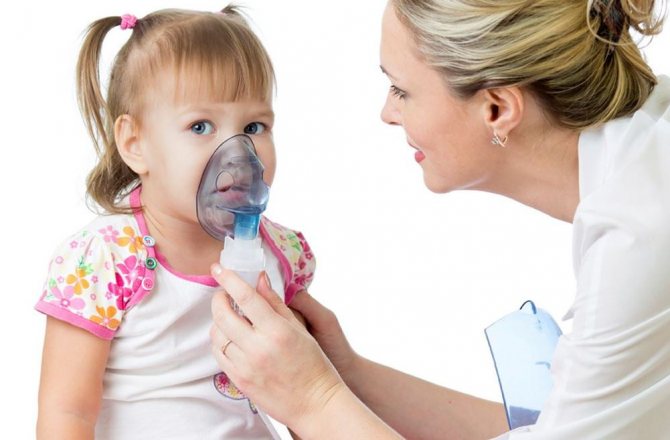
Indications for inhalation during a runny nose and cough in a child
- Acute and chronic rhinitis in the acute stage
- Acute tonsillitis - the presence of an inflammatory process in the tonsils
- Acute pharyngitis - the presence of an inflammatory process in the nasopharynx
- Acute and chronic bronchitis
- Pneumonia
Contraindications for inhalations
- Tendency to nosebleeds, hypertension
- Severe respiratory failure
- Cardiovascular failure
- Increased body temperature - more than 37.5 °
Separately, it is worth mentioning the fact that inhalations for children against coughs and runny noses at home require strict adherence to the pediatrician’s prescriptions, and it is strictly not recommended to independently select medications and carry out the procedure without first consulting a doctor!
How to make inhalation for cough and runny nose at home?
In order to carry out the inhalation procedure at home, you can use ultrasonic or steam inhalers, as well as use traditional methods of inhalation - a pan with steam, a coffee pot or a saucepan with a narrow spout. It is worth noting that when using modern inhalers, such as a nebulizer and a ulyzer, the effectiveness of the procedure is much higher than when using steam inhalers or “grandmother’s recipes” using a saucepan. Efficiency is achieved due to direct contact of the drug with the source of inflammation, which ensures the maximum local effect of the medication on the inflamed mucous membrane. Among other things, nebulizers are safer, as they are suitable for carrying out procedures for patients with high body temperature, and also eliminate the risk of burns from the use of hot steam, since the substance sprayed by the device maintains room temperature.
You might be interested in the article - How to properly use an inhaler for a cough?
If you still decide to use steam inhalation at home, you should follow the list of the following rules:
- The temperature of the steam should be checked on yourself for 2 minutes, and only after making sure that the steam does not burn, inhale the child;
- ensure that the child’s nose and lips do not touch the hot surface of the utensil used as an inhaler;
- strictly adhere to the dosage of the medication or composition of essential oils, since an incorrectly calculated dose of the substance can cause allergies or bronchospasm;
- Do not carry out the procedure for more than 3 minutes for children under 5 years old; for children over 5 years old, 5 minutes of the procedure will be enough;
What to use for inhalation for a child with a runny nose and cough?
For inhalations at home, herbal infusions, aqueous solutions of essential oils, as well as medications selected by the attending physician are used. Inhalation with a nebulizer for children for cough and runny nose may include the prescription of exclusively drug treatment, or a complex therapy option that uses both medications and gentle herbal infusions at the same time.
Among the most common recipes for children’s inhalation for coughs and runny noses, the following options are worth highlighting:
- Pour a tablespoon of chamomile flowers into a glass of boiling water, let it brew, and strain. Burn the infusion to the optimal temperature and perform steam inhalation for up to 5 minutes.
- The ancient and proven method of inhalation using potato vapors will be much more useful and effective if you add 2-3 drops of dill, anise, eucalyptus or pine essential oil to the water. This procedure will help relieve swelling of the nasal mucosa and make breathing much easier, but you should not exceed the specified dose of oil, since an excess of essential vapors, on the contrary, can dry out the mucous membrane of the larynx and cause irritation.
- Decoctions of yarrow, plantain, St. John's wort, calendula and eucalyptus are well suited for liquefying and evacuating mucus from the bronchi. Carrying out such procedures is permissible up to 3 times a day.
- Inhalations with alkaline water will be absolutely harmless and effective. Waters such as Borjomi or Narzan are suitable for the procedure. This recipe is suitable for treating cough and runny nose in infants, since it does not have any medicinal effect on the body, and the therapeutic effect is due to the high content of minerals in the composition of such inhalation.
- When coughing with complicated sputum production, soda inhalation will help. To prepare the mixture, you need to place 1 teaspoon of baking soda in a glass of purified water. This recipe will relieve cough and remove excess phlegm in the shortest possible time.
- Inhalations using essential oils are highly effective. In any pharmacy you can buy specially developed formulations of several essential oils and carry out the inhalation procedure 2 times a day for 3-4 minutes. This recipe is not recommended for people with allergies.
Inhalations with soda
For coughs and runny noses in children, it is not recommended to use baking soda in nebulizers. There is a danger that the powder will not dissolve well enough or will not be sufficiently sterile.
In compressor inhalers, sodium bicarbonate is used not in the form of baking soda, but in other similar compositions:
- Borjomi;
- Soda buffer.
Bottled mineral water is poured into the inhaler in its pure form, without diluting with saline solution. To obtain a stronger effect, you can purchase sodium bicarbonate in pharmaceutical form called Buffer Soda.
The liquid is clear and sterile, as it is available for injection. Thanks to this, it can be used for aerosol inhalations by first diluting 1:1.
It is not recommended to open the bottle. This significantly reduces the service life of the solution.
In order for the drug to last a long time and at the same time retain its original properties, the medicinal liquid must be taken out using a sterile syringe by piercing the rubber stopper. Then put it in the refrigerator.
The drug well alkalizes the mucus in the respiratory tract, thereby helping to liquefy it. Makes sputum discharge easier and faster. This product, combined with the latest technology (nebulizer), is much more effective than regular baking soda.
For adults and children, the cooking method is the same:
- saline solution – 2 ml;
- buffer soda – 2 ml.
The drug is used twice a day with an interval of 8 hours, no less. A few inhalations are enough to transform a dry cough into a wet one. It is also effective in treating a runny nose.
Medicines for inhalation for a child
As already noted, highly effective treatment can be achieved with the help of inhaled medications. However, self-medication can have a detrimental effect on your child’s health, therefore, before starting drug therapy in the form of inhalation, you should definitely consult with a doctor who will select the necessary medications for you and determine the duration of the course of treatment.
Among the prescriptions for inhalation for coughs and runny nose, there are 3 groups of drugs:
- Bronchodilators are drugs that can dilate bronchi that are susceptible to swelling due to bronchitis, asthma, and laryngitis. This group includes drugs such as Ventolin, Salbutamol, Berodual.
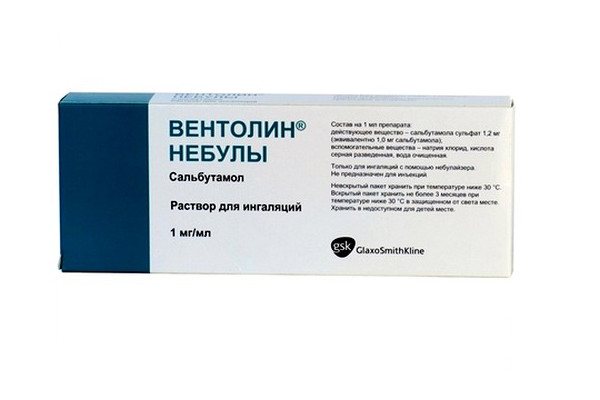
Ventolin for inhalation
- Mucolytics are agents that help thin mucus and speed up its removal from the body. Among the most common prescriptions by pediatricians are Ambroxol, Lazolvan, Ambrobene, and in older children of school age - ACC and Fluimucil.
You can find more detailed information in the article “Rotocan instructions for use, cost and analogues of the drug.”
source
Inhalation with a nebulizer
Using a nebulizer for procedures allows you to spray medicinal substances into tiny droplets and deliver them into the respiratory tract to the place where their action is important. For its operation, such a device can use ultrasound, a compressor or a special membrane.
Depending on the particles generated in the device, nebulizer inhalations can be directed to different parts of the respiratory tract. Medicines transferred into small particles will quickly enter the tissues of the respiratory system, and will also act on them longer and more effectively than with other methods of administration.
Solutions specially designed for use in such a device are poured into the nebulizer. Most often they are diluted in saline solution, and the use of herbal decoctions and oil solutions in most nebulizers is prohibited. Some models also have restrictions for medications, such as corticosteroid hormones.
The following substances are used for inhalation when coughing:
- Products that help moisturize and soften mucous membranes. These include salt and mineral water, saline solution, water with soda. Such moisturizers are especially often prescribed for dry coughs.
- Medications with a bronchodilator effect that help eliminate spasms in the respiratory tract. This group of drugs includes Berotec, Atrovent, Berodual and Ventolin. They are recommended for dry and allergic coughs.
- Agents with mucolytic action. Such drugs are Ambrobene, ACC, Bronchipret, Lazolvan, Mucaltin and others. They are indicated for both wet and dry coughs.
- Anti-inflammatory agents to reduce swelling and inflammation. This effect is provided by Tonzilgon N, Pulmicort, Cromohexal, Rotokan and other drugs. They are recommended for barking, allergic and wet coughs.
- Antitussive agents. These include Lidocaine and Tussamag. Such drugs are prescribed for barking cough.
- Antiseptic agents for cleansing mucous membranes. This group includes Chlorophyllipt, Furacilin, Miramistin and Dioxidin. Their purpose is indicated for wet or barking cough.
- Medicinal herbs with mucolytic, anti-inflammatory and emollient effects. Such herbs include sage, chamomile, coltsfoot, St. John's wort, mint, thyme and others. Their decoctions are used for dry coughs.
- Essential oils with anti-inflammatory and softening effects. This effect is observed in oils of pine, sea buckthorn, eucalyptus, almond and others. Inhalations with them are recommended for dry cough.
For information about why you should not do inhalations with boiled potatoes, see Dr. Komarovsky’s program.
Cough is one of the symptoms of many viral and bacterial respiratory tract infections: pharyngitis, tracheitis, bronchitis, pneumonia. The cough can be dry and wet (with sputum). One of the tasks in the treatment of these diseases is to thin the mucus and improve its elimination.
Inhalation therapy plays an important role in the treatment of respiratory pathologies. The advantage of the inhalation method of drug administration is the direct effect of the drug on the inflamed mucous membrane of the respiratory system and the spasmodic muscles of the bronchi.


